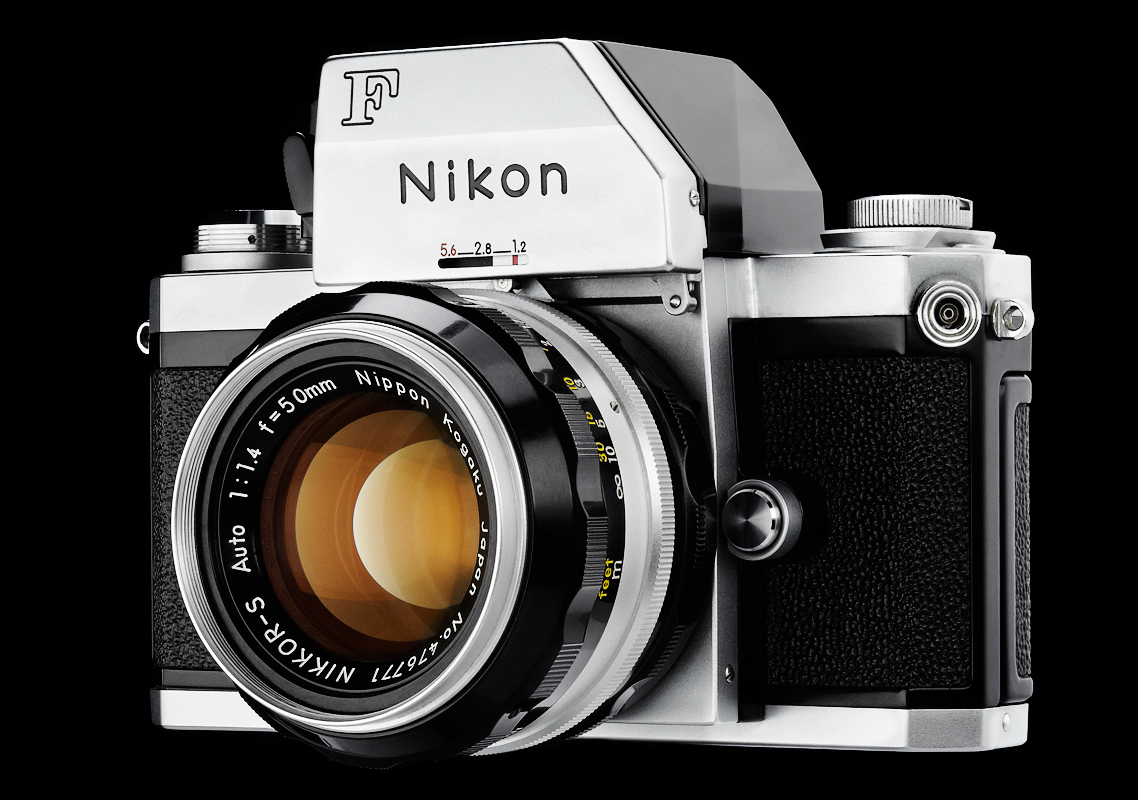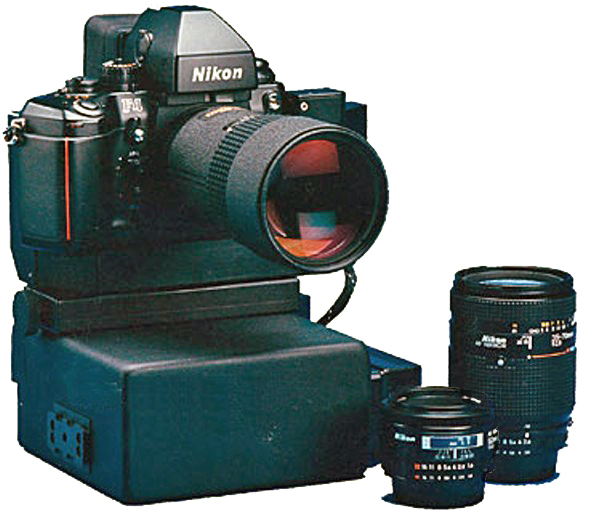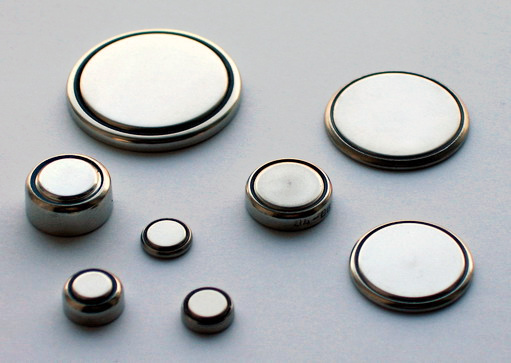|
Nikon EM
The Nikon EM is a beginner's level, interchangeable lens, 35 mm film, single lens reflex (SLR) camera. It was manufactured by Nippon Kogaku K. K. (today Nikon Corporation) in Japan from 1979 to 1982 (available new from dealer stock until circa 1984). The camera was designed for and marketed to the growing market of new photographers then entering the SLR buyer's market.">Nikon , Corporate Information , About Nikon , History , Nikon Family Cousins , Part 11 : "Nikon EM" The EM uses a MFC-E |
Nikon Corporation
(, ; ), also known just as Nikon, is a Japanese multinational corporation headquartered in Tokyo, Japan, specializing in optics and imaging products. The companies held by Nikon form the Nikon Group. Nikon's products include cameras, camera lenses, binoculars, microscopes, ophthalmic lenses, measurement instruments, rifle scopes, spotting scopes, and the steppers used in the photolithography steps of semiconductor fabrication, of which it is the world's second largest manufacturer. The company is the eighth-largest chip equipment maker as reported in 2017. Also, it has diversified into new areas like 3D printing and regenerative medicine to compensate for the shrinking digital camera market. Among Nikon's many notable product lines are Nikkor imaging lenses (for F-mount cameras, large format photography, photographic enlargers, and other applications), the Nikon F-series of 35 mm film SLR cameras, the Nikon D-series of digital SLR cameras, the Nikon Z-series of digital ... [...More Info...] [...Related Items...] OR: [Wikipedia] [Google] [Baidu] |
Olympus (company)
is a Japanese manufacturer of optics and reprography products. Olympus was established on 12 October 1919, initially specializing in microscopes and thermometers. Olympus holds roughly a 70-percent share of the global endoscope market, estimated to be worth approximately US$2.5 billion. Its global headquarters are located in Shinjuku, Tokyo, Japan. In 2011, Olympus attracted worldwide media scrutiny when it fired its CEO and the matter snowballed into a corporate corruption investigation with multiple arrests. It paid $646 million in kickback fines in 2016. Products Cameras and audio In 1936, Olympus introduced its first camera, the Semi-Olympus I, fitted with the first Zuiko-branded lens. The Olympus Chrome Six was a series of folding cameras made by Takachiho, and later Olympus, from 1948 to 1956, for 6×4.5 cm or 6×6 cm exposures on 120 film. The first innovative camera series from Olympus was the Pen, launched in 1959. It used a half-frame format, t ... [...More Info...] [...Related Items...] OR: [Wikipedia] [Google] [Baidu] |
Giorgetto Giugiaro
Giorgetto Giugiaro (; born 7 August 1938) is an Italian automotive designer. He has worked on supercars and popular everyday vehicles. He was born in Garessio, Cuneo, Piedmont. Giugiaro was named Car Designer of the Century in 1999 and inducted into the Automotive Hall of Fame in 2002. In addition to cars, Giugiaro designed camera bodies for Nikon, ''Navigation promenade'' of Porto Santo Stefano, in 1983, the organ of the cathedral of Lausanne (composed of about 7000 pipes) in 2003, and developed a new pasta shape, "Marille". He also designed several watch models for Seiko, mainly racing chronographs, as well as office furniture for Okamura Corporation. Influence on design Giugiaro's earliest cars, like the Alfa Romeo 105/115 Series Coupés, often featured tastefully arched and curving shapes, such as the De Tomaso Mangusta, Iso Grifo, and Maserati Ghibli. In the late 1960s, Giugiaro made increasingly angular designs, culminating in the "folded paper" era of the ... [...More Info...] [...Related Items...] OR: [Wikipedia] [Google] [Baidu] |
Zoom Lens
A zoom lens is a mechanical assembly of lens elements for which the focal length (and thus angle of view) can be varied, as opposed to a fixed-focal-length (FFL) lens (see prime lens). A true zoom lens, also called a parfocal lens, is one that maintains focus when its focal length changes. Most consumer zoom lenses do not maintain perfect focus, but are still parfocal designs. Most camera phones that are advertised as having optical zoom actually use a few cameras of different but fixed focal length, combined with digital zoom to make a hybrid system. The convenience of variable focal length comes at the cost of complexity – and some compromises on image quality, weight, dimensions, aperture, autofocus performance, and cost. For example, all zoom lenses suffer from at least slight, if not considerable, loss of image resolution at their maximum aperture, especially at the extremes of their focal length range. This effect is evident in the corners of the image, when displa ... [...More Info...] [...Related Items...] OR: [Wikipedia] [Google] [Baidu] |
Nikon MD-E
(, ; ), also known just as Nikon, is a Japanese multinational corporation headquartered in Tokyo, Japan, specializing in optics and Photography, imaging products. The companies held by Nikon form the Nikon Group. Nikon's products include cameras, camera lenses, binoculars, microscopes, ophthalmic lenses, measurement instruments, rifle scopes, spotting scopes, and the steppers used in the photolithography steps of Semiconductor device fabrication, semiconductor fabrication, of which it is the world's second largest manufacturer. The company is the eighth-largest chip equipment maker as reported in 2017. Also, it has diversified into new areas like 3D printers, 3D printing and regenerative medicine to compensate for the shrinking digital camera market. Among Nikon's many notable product lines are Nikkor imaging lenses (for Nikon F-mount, F-mount cameras, large format photography, photographic enlargers, and other applications), the Nikon F-series of 35mm format, 35 mm film SLR ... [...More Info...] [...Related Items...] OR: [Wikipedia] [Google] [Baidu] |
Nikon SB-E
(, ; ), also known just as Nikon, is a Japanese multinational corporation headquartered in Tokyo, Japan, specializing in optics and Photography, imaging products. The companies held by Nikon form the Nikon Group. Nikon's products include cameras, camera lenses, binoculars, microscopes, ophthalmic lenses, measurement instruments, rifle scopes, spotting scopes, and the steppers used in the photolithography steps of Semiconductor device fabrication, semiconductor fabrication, of which it is the world's second largest manufacturer. The company is the eighth-largest chip equipment maker as reported in 2017. Also, it has diversified into new areas like 3D printers, 3D printing and regenerative medicine to compensate for the shrinking digital camera market. Among Nikon's many notable product lines are Nikkor imaging lenses (for Nikon F-mount, F-mount cameras, large format photography, photographic enlargers, and other applications), the Nikon F-series of 35mm format, 35 mm film SLR ... [...More Info...] [...Related Items...] OR: [Wikipedia] [Google] [Baidu] |
Light Meter
A light meter is a device used to measure the amount of light. In photography, a light meter (more correctly an exposure meter) is used to determine the proper exposure for a photograph. The meter will include either a digital or analog calculator which displays the correct shutter speed and f-number for optimum exposure, given a certain lighting situation and film speed. Similarly, exposure meters are also used in the fields of cinematography and scenic design, in order to determine the optimum light level for a scene. Light meters are used in the general field of architectural lighting design to verify proper installation and performance of a building lighting system, and in assessing the light levels for growing plants. Use in photography The earliest type of light meters were called ''extinction meters'' and contained a numbered or lettered row of neutral density filters of increasing density. The photographer would position the meter in front of his subject and ... [...More Info...] [...Related Items...] OR: [Wikipedia] [Google] [Baidu] |
Polycarbonate
Polycarbonates (PC) are a group of thermoplastic polymers containing carbonate groups in their chemical structures. Polycarbonates used in engineering are strong, tough materials, and some grades are optically transparent. They are easily worked, molded, and thermoformed. Because of these properties, polycarbonates find many applications. Polycarbonates do not have a unique resin identification code (RIC) and are identified as "Other", 7 on the RIC list. Products made from polycarbonate can contain the precursor monomer bisphenol A (BPA). Structure Carbonate esters have planar OC(OC)2 cores, which confers rigidity. The unique O=C bond is short (1.173 Å in the depicted example), while the C-O bonds are more ether-like (the bond distances of 1.326 Å for the example depicted). Polycarbonates received their name because they are polymers containing carbonate groups (−O−(C=O)−O−). A balance of useful features, including temperature resistance, impact resistance and o ... [...More Info...] [...Related Items...] OR: [Wikipedia] [Google] [Baidu] |
Button Cell
A button cell, watch battery, or coin battery is a small single-cell battery shaped as a squat cylinder typically in diameter and high — resembling a button. Stainless steel usually forms the bottom body and positive terminal of the cell; insulated from it, the metallic top cap forms the negative terminal. Button cells are used to power small portable electronics devices such as wrist watches and pocket calculators. Wider variants are usually called coin cells. Devices using button cells are usually designed around a cell giving a long service life, typically well over a year in continuous use in a wristwatch. Most button cells have low self-discharge, holding their charge for a long time if not used. Relatively high-power devices such as hearing aids may use a zinc–air battery, which has a much higher capacity for a given size, but dries out after a few weeks even if not used. Button cells are single cells, usually disposable primary cells. Common anode materials are zinc ... [...More Info...] [...Related Items...] OR: [Wikipedia] [Google] [Baidu] |
Nikon EM With Nikkor 50 Mm F1
(, ; ), also known just as Nikon, is a Japanese multinational corporation headquartered in Tokyo, Japan, specializing in optics and Photography, imaging products. The companies held by Nikon form the Nikon Group. Nikon's products include cameras, camera lenses, binoculars, microscopes, ophthalmic lenses, measurement instruments, rifle scopes, spotting scopes, and the steppers used in the photolithography steps of Semiconductor device fabrication, semiconductor fabrication, of which it is the world's second largest manufacturer. The company is the eighth-largest chip equipment maker as reported in 2017. Also, it has diversified into new areas like 3D printers, 3D printing and regenerative medicine to compensate for the shrinking digital camera market. Among Nikon's many notable product lines are Nikkor imaging lenses (for Nikon F-mount, F-mount cameras, large format photography, photographic enlargers, and other applications), the Nikon F-series of 35mm format, 35 mm film SLR ... [...More Info...] [...Related Items...] OR: [Wikipedia] [Google] [Baidu] |
Nikon F
The Nikon F camera, introduced in April 1959, was Nikon's first SLR camera. It was one of the most advanced cameras of its day. Although many of the concepts had already been introduced elsewhere, it was revolutionary in that it was the first to combine them all in one camera. It was produced until October 1973 and was replaced by the Nikon F2. Aspects of its design remain in all of Nikon's subsequent SLR cameras, through the current Nikon F6 film and Nikon D6 digital models (which still share its Nikon F-mount for lenses). The "F" in Nikon F was selected from the term "re-f-lex", since the pronunciation of the first letter "R" is not available in many Asian languages. That tradition was carried all the way through their top line of Nikon cameras until the introduction of the Nikon D1 (digital) cameras decades later. Specially modified Nikon F cameras were used in space in the early 1970s aboard the Skylab space station. History The Nikon F was the first 35 mm SLR system ... [...More Info...] [...Related Items...] OR: [Wikipedia] [Google] [Baidu] |
Nikkormat
Nikkormat (Nikomat in Japan) was a brand of cameras produced by the Japanese optics company Nippon Kogaku K. K., as a consumer version of the professional Nikon brand. Nikkormat cameras, produced from 1965 until 1978, were simpler and more affordable than Nikon-branded cameras, but accepted the same lenses as the Nikon F series cameras. Note on the Nikkormat metering system The light meter indicates current whose value depends on the amount of light, and three user settings: aperture, shutter speed, and film sensitivity (film speed). In many cameras the three user settings each have a separate resistor with a moving contact. In the Nikkormat there is only a single resistor and a single moving contact: the resistor is on one ring and the contact on another of the concentric rings around the lens mount. The film sensitivity (speed) and the shutter speed combine their values on one ring, while the aperture determines the relative position of the second ring. Using only one ... [...More Info...] [...Related Items...] OR: [Wikipedia] [Google] [Baidu] |






